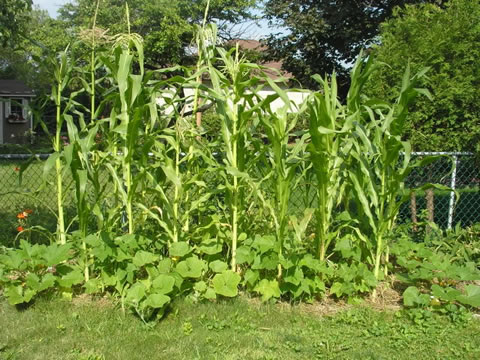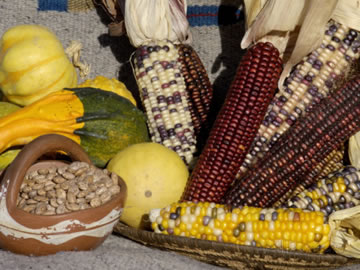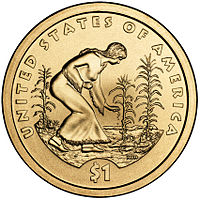 |
Canku Ota
|
 |
|
(Many Paths)
|
||
|
An Online Newsletter
Celebrating Native America
|
||
|
March 2015 - Volume
13 Number 3
|
||
|
|
||
|
Returning To Our
Native Roots Through Gardening
|
||
|
by Osage Nation Communities
of Excellence
|
||
 When
one needs to prepare a meal or just replenish food items in the cupboard,
a quick trip to the local grocery store or Wal-Mart takes care of
everything. However, before the convenience of such retail businesses
our Osage ancestors would have worked as a cooperative to provide
a sustainable food system of hunting and agriculture for the tribe.
Members would have provided particular services to the development
of the gardens, maintenance of the seeds, cultivation, and the harvest. When
one needs to prepare a meal or just replenish food items in the cupboard,
a quick trip to the local grocery store or Wal-Mart takes care of
everything. However, before the convenience of such retail businesses
our Osage ancestors would have worked as a cooperative to provide
a sustainable food system of hunting and agriculture for the tribe.
Members would have provided particular services to the development
of the gardens, maintenance of the seeds, cultivation, and the harvest.
The meals prepared from this ancestral-lifestyle would have been nutritious. They would have been balanced with meats and vegetables; void of sugar and bad fats. There would also have been exercise from the physical labor required in the working of the ground and harvest. So if this was such a healthy way to live, why do we read today about so many Native tribes returning to traditional planting methods and the use of heirloom seeds? Through the removal from- and encroachment upon- Native lands by Europeans and later American colonists and pioneers, this tradition ended. And as the Native populations integrated with American society unhealthy foods became part of their diet. This in turn eventually led to life-threatening illnesses, which included but were not limited to cancer, heart disease and diabetes. The Osage Nation Communities of Excellence program (COE) provides education about healthy lifestyles and “the process of disease prevention through good food choices, exercise, and being tobacco-free.” Last summer, COE and Ta-Wa AmeriCorps farmed three acres of pumpkins at 1st and Prudom Streets in Pawhuska. It was a “learning experience,” COE Director Gail Boe stated. Despite battling deer and raccoons, the group had a successful harvest of about 100 pumpkins. Some were given to the Soup Kitchen with the Immaculate Conception Catholic Church in Pawhuska. Pumpkin muffins were baked for the December Extravaganza event at the Cultural Center and over 400 baggies of treats were handed out.
Beans are a good source of protein, fiber and carbohydrates, which are needed for energy and brain function. Pumpkins are low in calories, rich in fiber, vitamins and minerals. The seeds also are a good source of protein. Corn has a unique role, in that, eaten off the cob it is considered a vegetable, but when the kernels are dried they become a grain. And the inclusion of corn in one’s diet is beneficial.
To learn more about Communities of Excellence and AmeriCorps and/or to participate in this year’s gardening projects contact their office at (918) 287-5267. |
|
|
||
|
|
||
| Canku Ota is a free Newsletter celebrating Native America, its traditions and accomplishments . We do not provide subscriber or visitor names to anyone. Some articles presented in Canku Ota may contain copyright material. We have received appropriate permissions for republishing any articles. Material appearing here is distributed without profit or monetary gain to those who have expressed an interest. This is in accordance with Title 17 U.S.C. Section 107. | ||
|
Canku Ota is a copyright ©
2000 - 2015 of Vicki Williams Barry and Paul Barry.
|
||
 |
 |
|
|
The "Canku
Ota - A Newsletter Celebrating Native America" web site and
its design is the
|
||
|
Copyright ©
1999 - 2015 of Paul C. Barry.
|
||
|
All Rights Reserved.
|
||
 Pumpkins
and squash, corn, and beans when planted together are a natural
combination. The stalks of the corn allow the vining beans a place
of support. The leaf structure of the squash provides shade. The
food is easy to store and keep for long periods of time. Then of
course there is the nutritional value of each item.
Pumpkins
and squash, corn, and beans when planted together are a natural
combination. The stalks of the corn allow the vining beans a place
of support. The leaf structure of the squash provides shade. The
food is easy to store and keep for long periods of time. Then of
course there is the nutritional value of each item. The
Communities of Excellence program is beginning the planning stages
of this year’s gardening endeavors. There is the acreage of
1st and Prudom. Another location is the small heirloom garden at
the WAHZHAZHI Cultural Center which will only be planted with corn
this time; a variety that is shorter than the average plant and
with small ears. Bird Creek Farms will also be available for planting,
[and more about that location will follow in another article]. Similar
to the old ways where the tribe worked together to maintain a reliable
food source, COE staff with the Ta-Wa AmeriCorps team will also
be joined by other Osage Nation departments and personnel. It takes
many individuals to do this hard work, but all teams are excited
to get started.
The
Communities of Excellence program is beginning the planning stages
of this year’s gardening endeavors. There is the acreage of
1st and Prudom. Another location is the small heirloom garden at
the WAHZHAZHI Cultural Center which will only be planted with corn
this time; a variety that is shorter than the average plant and
with small ears. Bird Creek Farms will also be available for planting,
[and more about that location will follow in another article]. Similar
to the old ways where the tribe worked together to maintain a reliable
food source, COE staff with the Ta-Wa AmeriCorps team will also
be joined by other Osage Nation departments and personnel. It takes
many individuals to do this hard work, but all teams are excited
to get started.